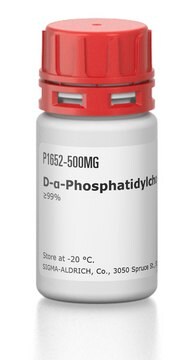Kluczowe dokumenty
850475C
Avanti
18:1-16:0 PC
1-oleoyl-2-palmitoyl-sn-glycero-3-phosphocholine, chloroform
Synonim(y):
1--(9Z-oktadecenylo)-2-heksadekanoilo-sn-glicero-3-fosfocholina; OPPC; PC(18:1(9Z)/16:0)
About This Item
Polecane produkty
Próba
>99% (TLC)
Formularz
liquid
opakowanie
pkg of 1 × 2.5 mL (850475C-25mg)
pkg of 2 × 4 mL (850475C-200mg)
producent / nazwa handlowa
Avanti Research™ - A Croda Brand 850475C
stężenie
10 mg/mL (850475C-25mg)
25 mg/mL (850475C-200mg)
typ lipidu
cardiolipins
phospholipids
Warunki transportu
dry ice
temp. przechowywania
−20°C
ciąg SMILES
[P](=O)([O-])(OC[C@H](OC(=O)CCCCCCCCCCCCCCC)COC(=O)CCCCCCC\C=C/CCCCCCCC)OCC[N+](C)(C)C
InChI
1S/C42H82NO8P/c1-6-8-10-12-14-16-18-20-21-23-24-26-28-30-32-34-41(44)48-38-40(39-50-52(46,47)49-37-36-43(3,4)5)51-42(45)35-33-31-29-27-25-22-19-17-15-13-11-9-7-2/h20-21,40H,6-19,22-39H2,1-5H3/b21-20-/t40-/m1/s1
Klucz InChI
RRVPPYNAZJRZFR-VYOBOKEXSA-N
Opis ogólny
Zastosowanie
- jako wzorzec lipidowy w analizach ultra-wydajnej chromatografii cieczowej (UPLC)
- jako składnik liposomów do badania proliferacji komórek kilku linii komórkowych
- w liposomach do eksperymentów sieciowania
Działania biochem./fizjol.
Opakowanie
Informacje prawne
Hasło ostrzegawcze
Danger
Zwroty wskazujące rodzaj zagrożenia
Zwroty wskazujące środki ostrożności
Klasyfikacja zagrożeń
Acute Tox. 3 Inhalation - Acute Tox. 4 Oral - Carc. 2 - Eye Irrit. 2 - Repr. 2 - Skin Irrit. 2 - STOT RE 1 Oral - STOT SE 3
Organy docelowe
Liver,Kidney, Respiratory system
Kod klasy składowania
6.1D - Non-combustible acute toxic Cat.3 / toxic hazardous materials or hazardous materials causing chronic effects
Klasa zagrożenia wodnego (WGK)
WGK 3
Temperatura zapłonu (°F)
does not flash
Temperatura zapłonu (°C)
does not flash
Wykazy regulacyjne
Wykazy regulacyjne dotyczą głównie produktów chemicznych. Można w nich podawać ograniczoną liczbę informacji na temat produktów niechemicznych. Brak wpisu oznacza, że żaden ze składników nie znajduje się w wykazie. Użytkownik odpowiada za zagwarantowanie bezpiecznego i zgodnego z prawem stosowania produktu.
EU REACH Annex XVII (Restriction List)
Wybierz jedną z najnowszych wersji:
Certyfikaty analizy (CoA)
It looks like we've run into a problem, but you can still download Certificates of Analysis from our Dokumenty section.
Proszę o kontakt, jeśli potrzebna jest pomoc Obsługa Klienta
Masz już ten produkt?
Dokumenty związane z niedawno zakupionymi produktami zostały zamieszczone w Bibliotece dokumentów.
Nasz zespół naukowców ma doświadczenie we wszystkich obszarach badań, w tym w naukach przyrodniczych, materiałoznawstwie, syntezie chemicznej, chromatografii, analityce i wielu innych dziedzinach.
Skontaktuj się z zespołem ds. pomocy technicznej










